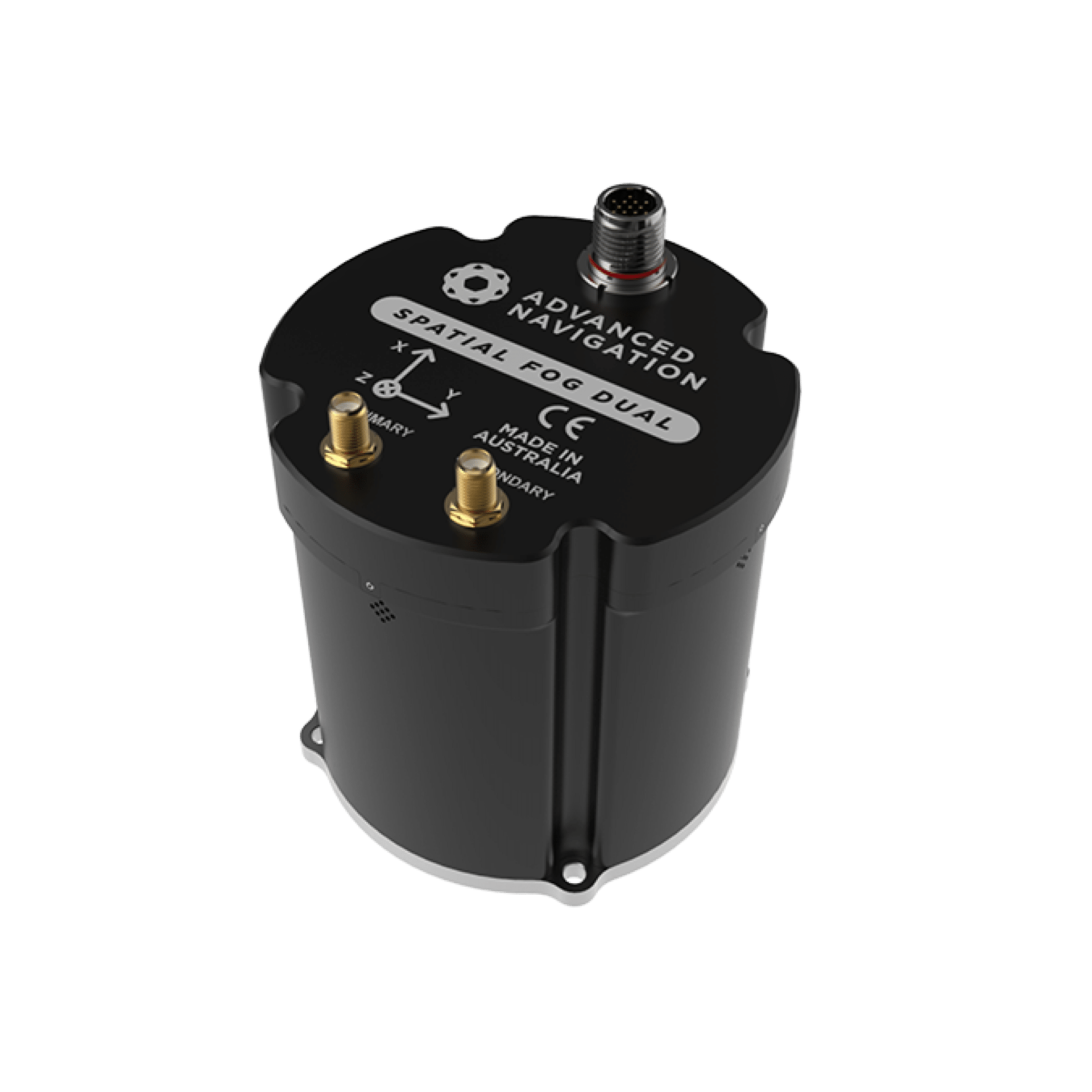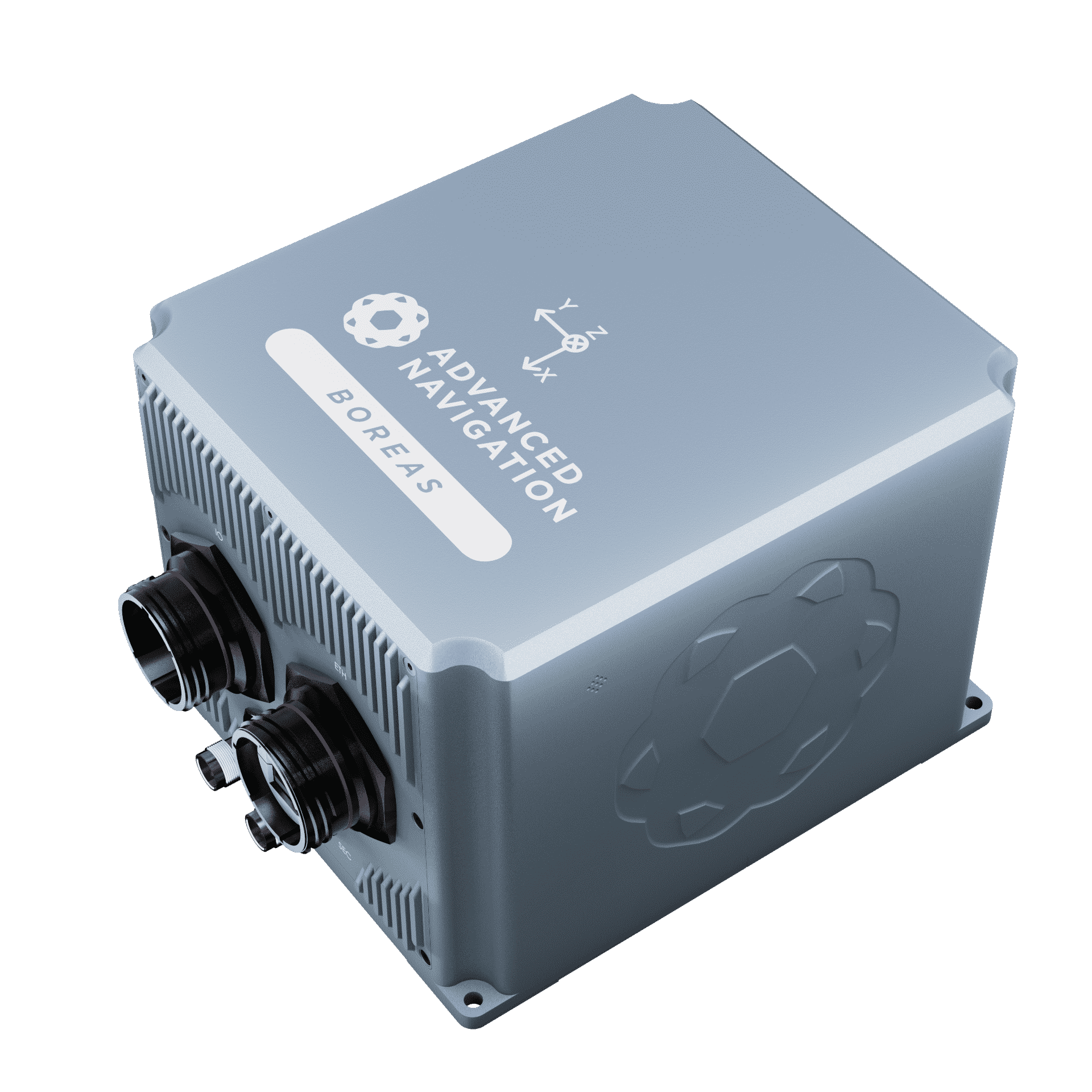Advanced Navigation is a leading manufacturer of fibre-optic gyroscopes (FOG) and digital fibre-optic gyroscope (DFOG) inertial navigation systems (INS). While all our fibre-optic gyroscope INS offer highly accurate position and navigation data, our patent pending DFOG INS goes even further, combining closed-loop fibre-optic gyroscope with digital modulation techniques and a revolutionary optical chip to offer strategic grade performance with a 40% reduction in size and cost over comparable products. The Advanced Navigation range of FOG-based INS features temperature-calibrated accelerometers, gyroscopes, magnetometers, and pressure sensors with state-of-the-art RTK GNSS receivers. These are coupled in an AI-based fusion algorithm.
This proprietary neural network has a higher level of health monitoring and instability prevention than the traditional Kalman filter. The sensor error tracking is faster and significantly more accurate, ensuring precise and reliable navigation data in the most demanding conditions. This hardware-software combination enables our fibre-optic gyroscopes to deliver the highest performance for the lowest SWaP-C (Size, Weight, Power Consumption, and Cost)
Our FOG INS come standard with dual antenna GNSS receivers that support all current navigational satellite constellations, including GPS, GLONASS, GALILEO, BeiDou and QZSS.
Advanced Navigation applies vertical integration for both software and hardware engineering, design and manufacturing. This enables the two systems to be completely complimentary and enables our products to set new benchmarks for accurate navigation in GNSS-denied environments.
Advanced Navigation fibre-optic gyroscopes are backed by a global support network and are suitable for both commercial and defence applications.
Our FOG INS Solutions
From navigation to strategic grade, our fibre-optic gyroscopes offer the lowest SWaP-C (Size, Weight, Power, and Cost) in each class.
All Advanced Navigation INS use a common communication protocol, enabling customers to extend their product range by moving up or down the accuracy spectrum without incurring re-engineering costs.
Spatial FOG Dual
Industry-proven FOG INS
Roll & Pitch
0.01 °
Heading (GNSS)
0.01 °
Bias Instability
0.1 °/hr
Position Accuracy
10 mm
Boreas D70
GNSS/INS with automatic Gyrocompassing
Roll & Pitch
0.01 °
Heading (GNSS)
0.01 °
Bias Instability
0.01 ° /hr
Position Accuracy
10 mm
Boreas D90
The world’s first fully digital FOG
Roll & Pitch
0.005 °
Heading (GNSS)
0.006 °
Bias Instability
0.001 ° /hr
Position Accuracy
10 mm
Why Choose Advanced Navigation

High Performance
Our systems deliver the highest performance and richest feature set on the market. We back our performance claims with free product trials.

Trusted Reliability
All our systems are designed and tested to safety standards with fault tolerance built in to provide you with the highest reliability possible. Our reliability is trusted by many of the world’s largest companies.

Quality
Our systems are built to the highest quality standards in Australia to endure the test of time in the most difficult conditions. You can rely on our products.
They Trust Us




Common Questions about FOG GNSS/INS
What is a fibre optic gyroscope?
A fibre-optic gyroscope (FOG) is a device used to measure angular velocity and orientation. It provides extremely accurate rotational rate information while being low maintenance and offering a long lifespan.
Fibre optic gyroscopes have become more affordable and the technology has proved to be beneficial for an expanding array of different high-performance inertial navigation systems (INS). As a result, FOGs have become the default choice for strategic and tactical grade applications that demand long-term navigation in environments where the use of GNSS (global navigation satellite system) is denied.
How does a FOG-based inertial navigation system work?
For an INS, typically, three gyroscopes on axes orientated orthogonal to one another, combined with accelerometers provide the sensed acceleration and rotation across six degrees of freedom (6DOF).
Combined with an estimate of gravity, a velocity is established, which integrated over time allows a position to be maintained for the purpose of dead reckoning.
FOG-based navigation systems are often used with other types of sensors to provide robust estimates of position and heading. Traditional systems have used magnetometers to estimate true north, although these are very vulnerable to interference from numerous sources, and lack sufficient accuracy for precision or high-speed applications.
Dual-antenna GNSS-based systems are increasingly preferred to magnetometer-based compasses to provide the best available heading accuracy for vehicles and systems with a clear view of the sky. High-performance FOGs can provide an advantage to these systems, allowing very small changes in heading to be measured that would not be detectable using dual-antenna heading methods alone.
FOGs and similar high-grade gyroscope technologies also offer another means of determining heading that is not available to MEMS-based systems: the ability to establish a heading via north-seeking based on the rotation of the earth (gyro compassing). This purely passive method allows a system to measure the slight changes of orientation that occur as the vehicle or system rotates around the earth’s axis. In addition to operating effectively where GNSS is unreliable or denied, these are relatively immune to magnetic interference. They do however lose accuracy at very high latitudes.
What are the differences between Fibre Optic Gyroscopes and MEMS Gyroscopes?
A MEMS (micro-electromechanical systems) gyroscope is a smaller, lightweight gyroscope made from microscopic devices. MEMS gyroscopes have a significantly lower SWaP-C, meaning they’re preferred in applications where a small payload is necessary.
FOGs have higher inertial performance and lower bias, making them the preferred solution for GNSS-denied environments or high accuracy applications such as antenna pointing.
What can a fibre optic gyroscope be used for?
The fibre optic gyroscope technology is conducive to a growing variety of applications where accurate headings and navigation are crucial. This includes manned vehicles and unmanned vehicles.
- Surface marine vehicles: Marine surveying vessels use FOGs to determine pitch, roll, and heading in real-time, as well as to establish accurate position data for Unmanned Underwater Vehicles (UUVs). They are particularly useful for side-scan sonar and similar applications.
- Subsea vessels: Manned vehicles (such as submarines) and UUVs (unmanned underwater vehicles), including autonomous underwater vehicles (AUV) and remotely operated vehicles (ROV), rely on fibre optic gyroscopes for accurate navigation in an incredibly challenging and hazardous environment with minimal or unreliable sources of absolute position. ROVs and AUVs used for hydrography benefit greatly from the precision of FOGs in particular.
- Aviation: Helicopters can be subjected to electromagnetic interference and benefit greatly from FOG-based INS. Unmanned Aerial Vehicles (UAVs) and commercial aircraft often require FOG-grade performance to mitigate the risks of losing GNSS position while in flight. The accuracy of roll, pitch and yaw data is essential to safely operating the aircraft.
- Defense: Land-based defence vehicles must not be reliant on GPS/GNSS due to the risk of local jamming or spoofing of these signals or simply terrain blocking or altering positioning data from satellites. FOG-based INS can allow these vehicles to operate seamlessly, preventing adversaries from gaining an advantage from these tactics.
- Space exploration: Fibre Optic Gyroscopes are well suited to space applications due to their long lifespan, little need for maintenance, minimal power consumption, and precise navigational data.
- Robotics: Orientation data from a fibre optic gyroscope is used for robotic navigation, ensuring safe operation as adjustments are made for any changes in velocity, position, or acceleration.
What is gyro-compassing?
Gyro-compassing means to determine the direction of true (geographic) north based on measurements from gyroscopes without external aid from GNSS. These high-performance gyroscopes are typically fibre-optic gyroscopes (FOG) or ring laser gyroscopes (RLG) types.
These gyroscopes are sensitive enough to measure the rate of angular rotation of the Earth. The ability to gyro-compass is important for applications where, due to the operating environment, there are little to no GNSS signals or there are requirements for very high-quality/reliable navigation.
Typical applications where gyro-compassing is important to include:
- Subsea navigation
- Underground navigation (tunnels, mines)
- Maritime navigation
- Military applications
- Space
How does a fibre optic gyroscope work?
A fibre optic gyroscope uses the properties of light in a closed circuit to estimate changes in orientation. Two beams of light are sent in opposite directions in a fibre optic coil.
As the vehicle rotates, the beam travelling against the rotation experiences a slightly shorter path delay than the other beam, a phenomenon called the Sagnac effect. The difference in phase shift between the two beams is then used to estimate the rate of rotation.
What are the advantages of fiber optic gyroscopes for inertial navigation?
- Extremely precise rotation measurement
- Reliability and a long lifetime due to lack of moving parts
- High-performance long-term navigation when no absolute source of
- position is available
- Maintenance-free
What are the differences between ring laser gyroscopes and fibre optic gyroscopes?
Like a FOG, a ring laser gyroscope (RLG) is an optical gyroscope that utilises the Sagnac effect. The key difference between the two is in how they are constructed, as ring laser gyroscopes use lasers that travel through a system of mirrors to determine a vehicle’s rotation, rather than a simple fibre coil.
As well as requiring extremely high manufacturing accuracy and special mirrors, RLGs are gas-filled and require the laser to be “dithered” or mechanically vibrated in order to prevent laser lock-in from erasing small rotations.
While both gyroscopes operate on similar principles and are exceptionally accurate, the older ring laser gyroscope technology is more delicate given its construction, requires more maintenance, and is typically more expensive. In contrast, a fibre optic gyroscope is a solid-state piece that doesn’t utilise a dithering mechanism, meaning it won’t produce any acoustic vibrations, making it more durable and reliable than an RLG. Furthermore, the applications of fibre optic gyroscopes can be scaled by altering the length and diameter of the fibre optic coil.
What is ITAR and how does it apply to FOG INS?
ITAR (International Traffic in Arms Regulations) is a control mechanism that regulates the manufacture, sale, and distribution of defence and space-related products and services as defined in the United States Munitions List (USML). If a product is listed under USML, it is subject to ITAR.
ITAR-listed products can pose a challenge to companies as additional administration is required for product clearance during import and export as well as restrictions on who the product can be sold to.
How does ITAR apply to something like an INS?
While the USML list deals with clearly defence-related items (for example, armaments, ammunition, explosives), other items on the USML list are not so obvious. Examples include gyroscope and accelerometer sensors (of U.S origin) that have the potential to be used for military applications. If an INS contains a USML-listed gyroscope or accelerometer, the INS will also be subject to ITAR controls.
All Advanced Navigation products are ITAR-free.
Get In Touch
Please fill out the form below, and our team will get back to you shortly.




